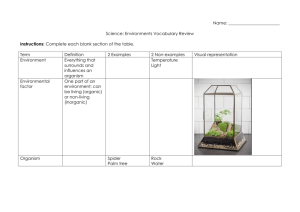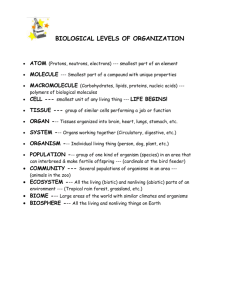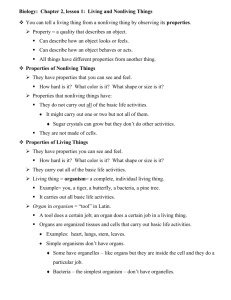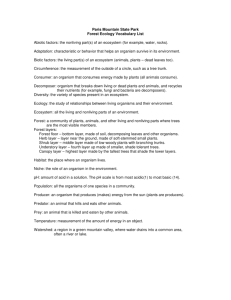File
advertisement
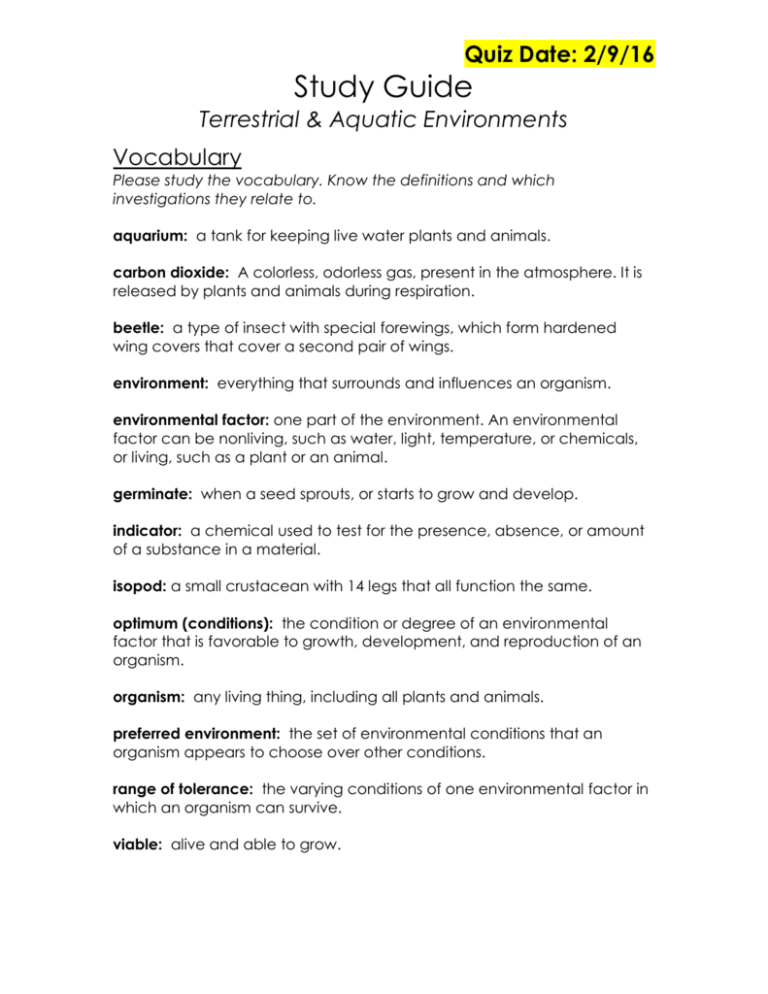
Quiz Date: 2/9/16 Study Guide Terrestrial & Aquatic Environments Vocabulary Please study the vocabulary. Know the definitions and which investigations they relate to. aquarium: a tank for keeping live water plants and animals. carbon dioxide: A colorless, odorless gas, present in the atmosphere. It is released by plants and animals during respiration. beetle: a type of insect with special forewings, which form hardened wing covers that cover a second pair of wings. environment: everything that surrounds and influences an organism. environmental factor: one part of the environment. An environmental factor can be nonliving, such as water, light, temperature, or chemicals, or living, such as a plant or an animal. germinate: when a seed sprouts, or starts to grow and develop. indicator: a chemical used to test for the presence, absence, or amount of a substance in a material. isopod: a small crustacean with 14 legs that all function the same. optimum (conditions): the condition or degree of an environmental factor that is favorable to growth, development, and reproduction of an organism. organism: any living thing, including all plants and animals. preferred environment: the set of environmental conditions that an organism appears to choose over other conditions. range of tolerance: the varying conditions of one environmental factor in which an organism can survive. viable: alive and able to grow. Investigations #1-3 Concept Review Foss Investigation Investigation #1 Terrestrial Environments Investigation #2 Bugs & Beetles Investigation #3 Water Tolerance Summary We created terrariums and grew five types of seeds: radish, pea, barley, clover, and corn. We observed the seeds to see if germination (sprouting) occurred. We found that over time, environments change. Some (but not all) of our plants grew, and we found that plants need water and light to grow. We designed investigations to control the variables so that the effect of one environmental factor could be observed. We varied the amount of water and light. We found that isopods prefer moist, or mostly wet environments, and that darkling beetles usually prefer dry environments. Isopods and beetles usually prefer dark environments. We set up a controlled experiment where we manipulated one variable (amount of water) in each environment. We then observed the plants at 5 and 8 days to see whether the plants had a different range of tolerance for water. Within the range of tolerance, the condition or conditions where the plants grew best defined our range of tolerance. Science Content everything that surrounds an organism makes up the organism’s environment an environmental factor is one part of an environment. It can be living or nonliving environments have both living and nonliving components organisms are living creatures designing an investigation involves controlling the variables so that one factor can be observed at a time we found that each organism has a set of preferred environmental conditions organisms have ranges of tolerance for environmental factors organisms have specific requirements for successful growth, development, and reproduction optimum conditions are those that are most favorable and produce the maximum growth, development, and reproduction Investigations #4 Concept Review Reread these investigation summaries to remember what we did together in class! You may want to highlight or underline important facts and vocabulary to study for the quiz! Foss Investigation Investigation #4 Aquatic Environments Summary We created aquariums that included conditioned (dechlorinated) tap water and goldfish. We considered the environmental factors in the aquarium that included the conditioned tap water, light and heat, aquarium walls, gases and other materials in the water, and other goldfish. Science Content Water quality and temperature are two important nonliving environmental factors to consider when setting up a goldfish aquarium. We added the chemical BTB to three different types of water to test for the presence of acid. We found that water with the goldfish in it had the highest acidity (turned yellow). Carbon dioxide produced by aquatic organisms changes the acidity of the water. An aquatic environment can contain many different organisms. Multiple Choice and Fill in the Blank Practice 1.) The environment an organism chooses to live in is their preferred environment. 2.) Light, water, soil, and temperature are examples of environmental factors. 3.) The optimum environments for beetles would be dark and dry. 4.) To find the optimum (best) conditions for an organism, you must: a.) set up a controlled experiment b.) choose one variable (such as salt) to change in the experiment c.) just watch the organism in one condition to see if it likes it or not. d.) both a and b 5.) If the chemical BTB is added to conditioned water from a goldfish aquarium and the water turns a yellow color, you can assume that: a.) the water is dirty b.) fish have been spitting out germs in the water. c.) fish are exhaling carbon dioxide into the water, causing the level of acidity to rise. d.) both a and b 3.) True To improve an aquatic environment for goldfish, you could add water plants such as elodea, small pond snails, or other small crustaceans (for the goldfish to eat). 4.) True: Experiments to determine the range of tolerance for living organisms takes time and close observation. The conditions where the organisms appear to thrive (do best) will be the optimum (best) conditions. 5.) Which of the following is an example in which organisms may still be alive and able to grow (viable), but might appear to be not viable because the conditions are wrong (not optimal)? a.) A plant seed may appear not viable until it receives the appropriate amount of water so the seed can germinate and the plant can grow. b.) Fish float at the top of the water when the water is not clean. c.) Brine shrimp may appear not viable unless the water you hatch them in is at an appropriate salt concentration. d.) a and c only e.) all of the above Essay Question Preparation 1. What is the relationship between an organism’s range of tolerance and its optimum condition. ANSWER: An organism’s optimum living conditions can be found within its range of tolerance. For example, if you set up a controlled experiment to test the range of tolerance of water on a radish seed, you would find out how much water would be the optimum amount to use for maximum growth and development within the range of tolerance tested. 2. Set up a controlled experiment to test the range of tolerance for light. You must use all of these supplies in your experiment: 3 containers, soil, water, 6 sunflower seeds, and a measuring cup. (Hint: Remember the other plant experiment that we did!) 1. Put one cup of soil in each of the three containers. 2. Place 2 sunflower seeds in the same place in each of the three containers on top of the soil. 3. Cover the seeds with some more soil. 4. Measure an equal amount (20 ml) of water to pour in each container. Pour onto soil and seeds. 5. Place one container in an area with direct sunlight, one in an area with partial sunlight, and one in a dark area. 6. Wait for a few days. Observe and record any growth in the three containers. 7. After about a week or 8 days, determine which container has the most observable growth. That container will have the optimum conditions for growing sunflower seeds. 3. After Ms. Larson’s class discovered the best condition to hatch brine shrimp eggs, the class decided to hatch more eggs. This time, when making the salt solution, Ms. Larson accidentally used a different-size spoon for measuring the salt and used the same amount of water. Even with this different solution, most of the shrimp eggs hatched anyway. Explain why. Answer: Brine shrimp eggs can hatch in a range of salt conditions, so even though Ms. Larson’s class may not have hatched the eggs in their optimum conditions, some eggs would hatch anyway. 4. Look at the picture of the saltwater aquarium above, and answer these questions. a. List the environmental factors that make up the aquatic environment. aquarium/tank water thermometer snail (L) water filter/bubbler shells light/lamp gravel/sand fish (L) rocks water plants (L) b. Look at your list ABOVE and mark an L on your list next to all of the LIVING environmental factors. c. Describe how the nonliving factors might influence the living factors in this aquarium environment. An example of a nonliving factor influencing a living factor would be if the temperature (nonliving) got too high then the fish (living) might die. Also, if the lamp (nonliving) was too bright/hot or too dim/cold, then the fish, snails, and water plants (living) might not be in their optimum conditions and could die (or not be as healthy). A rock (nonliving) could provide a hiding place or shelter for a fish (living) in the aquarium.

